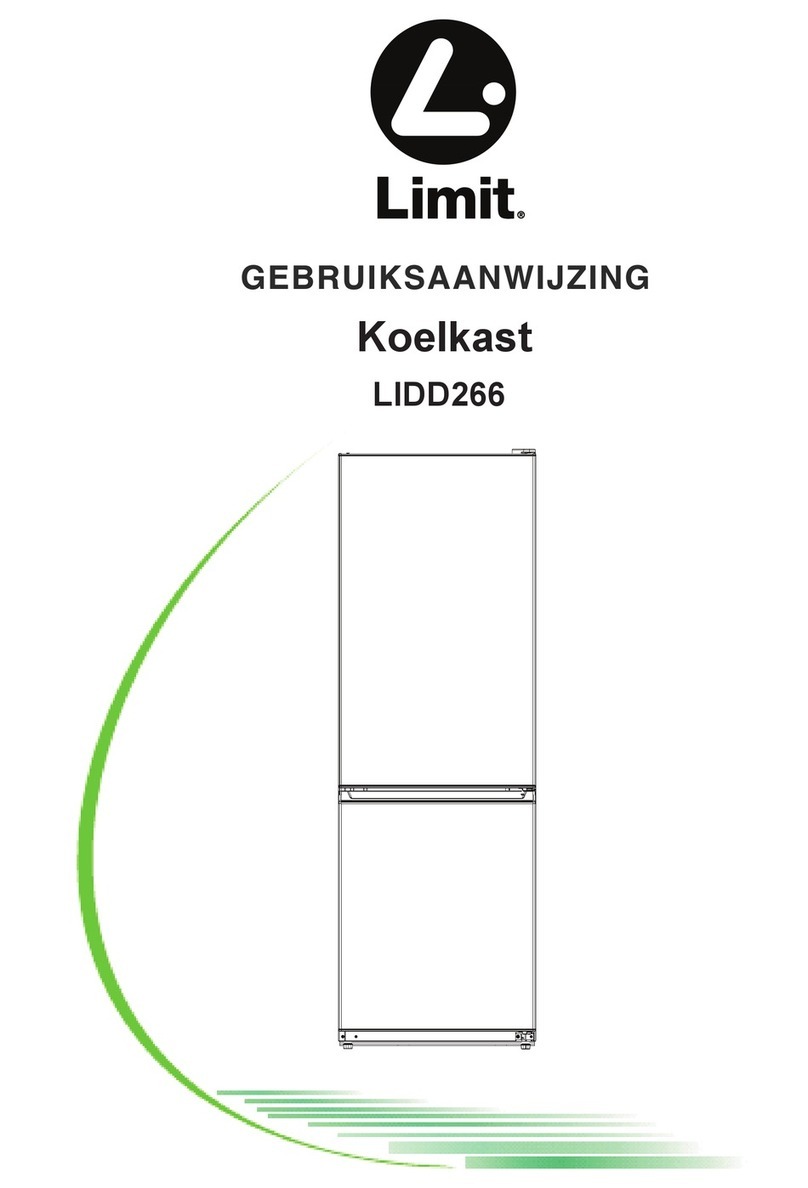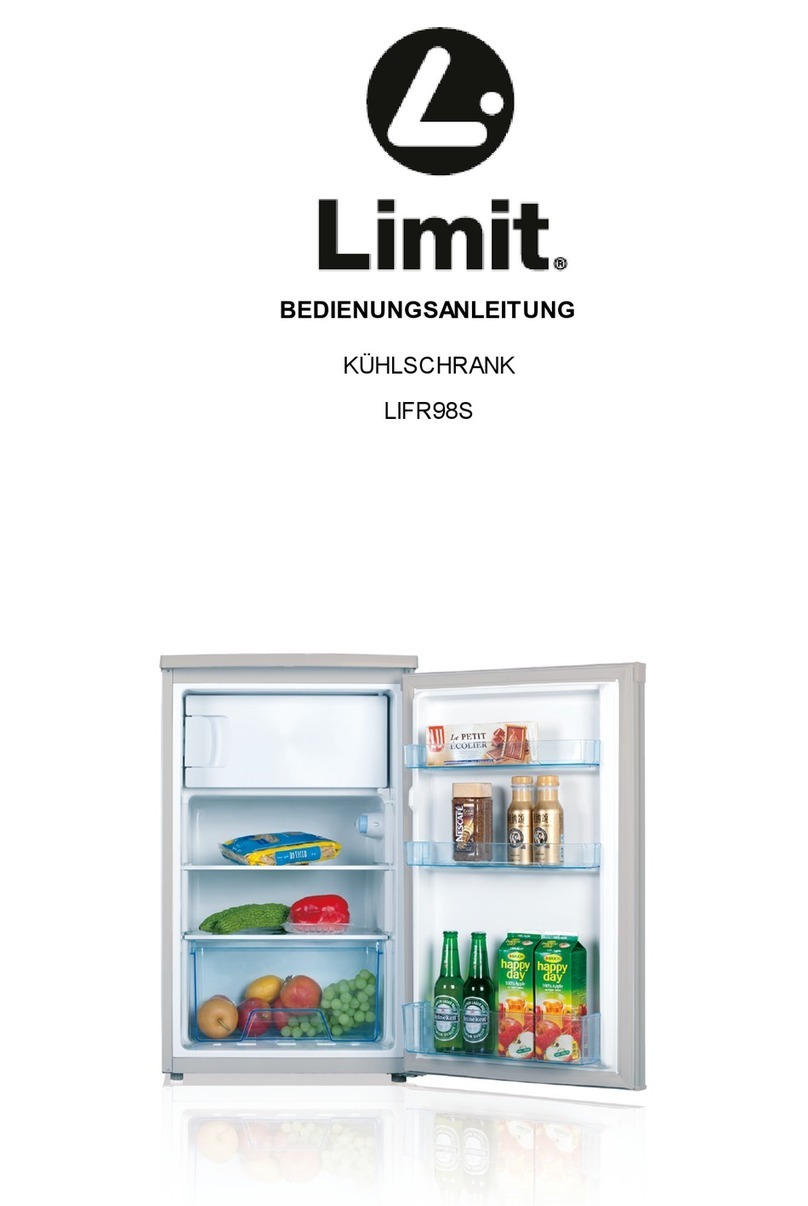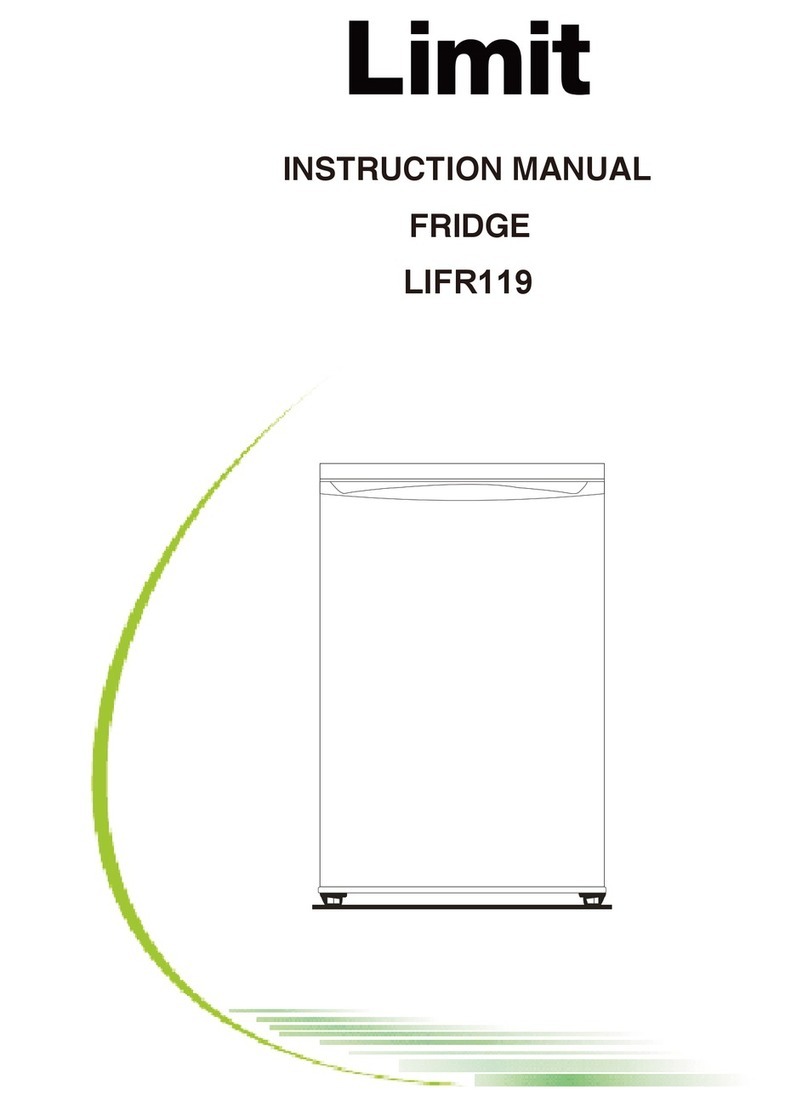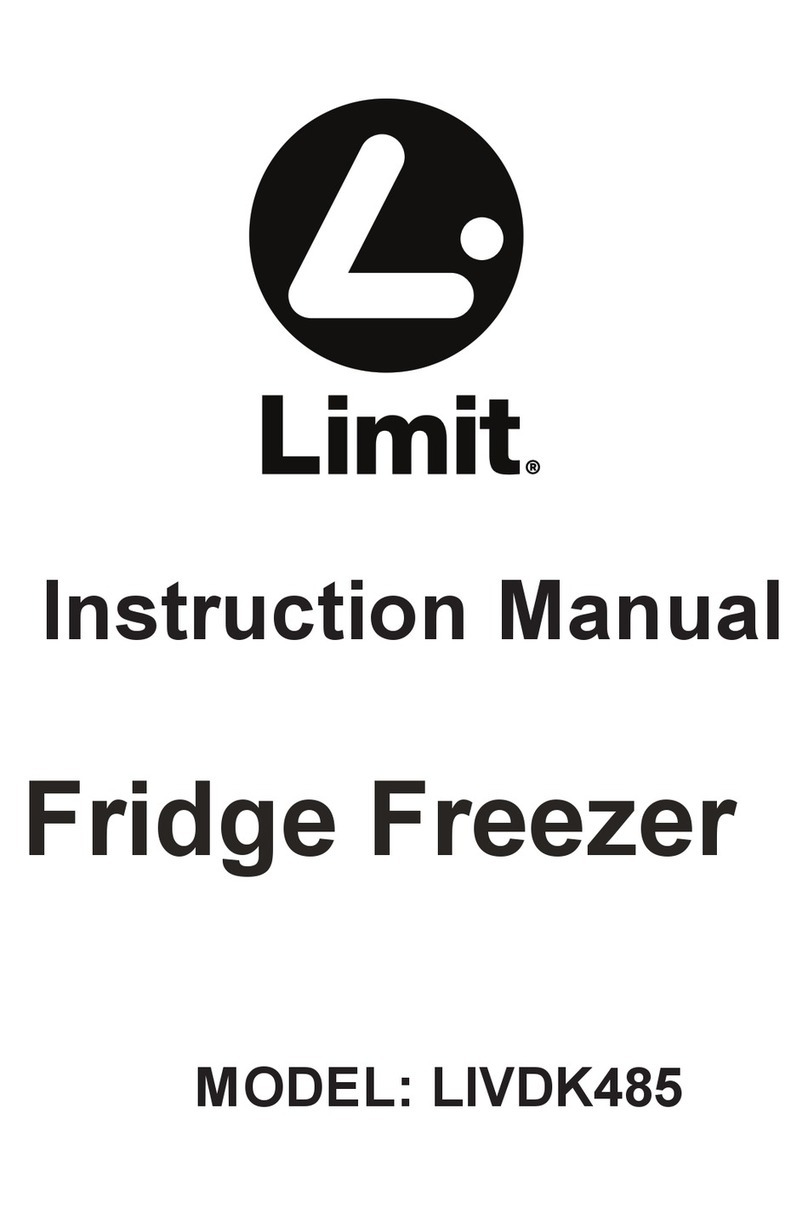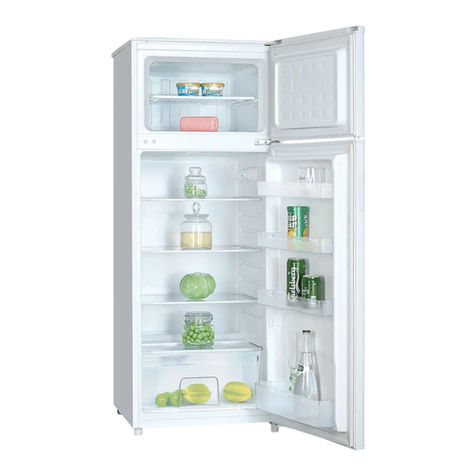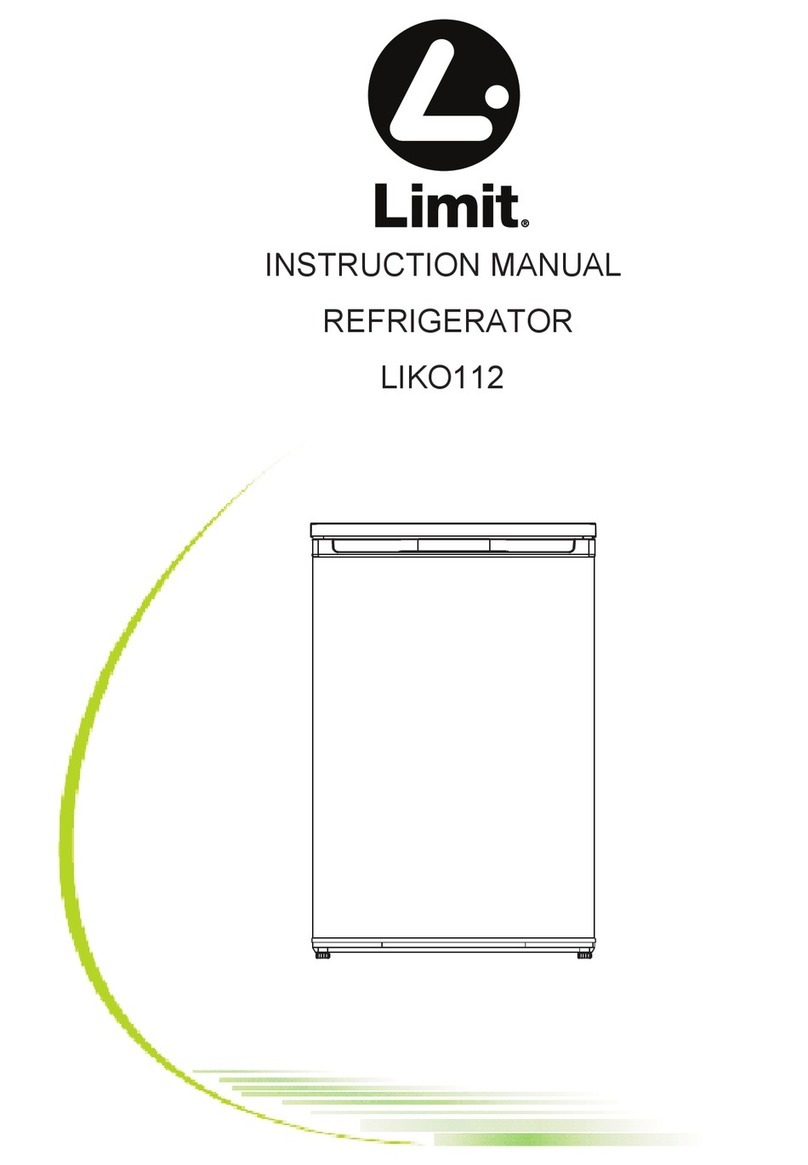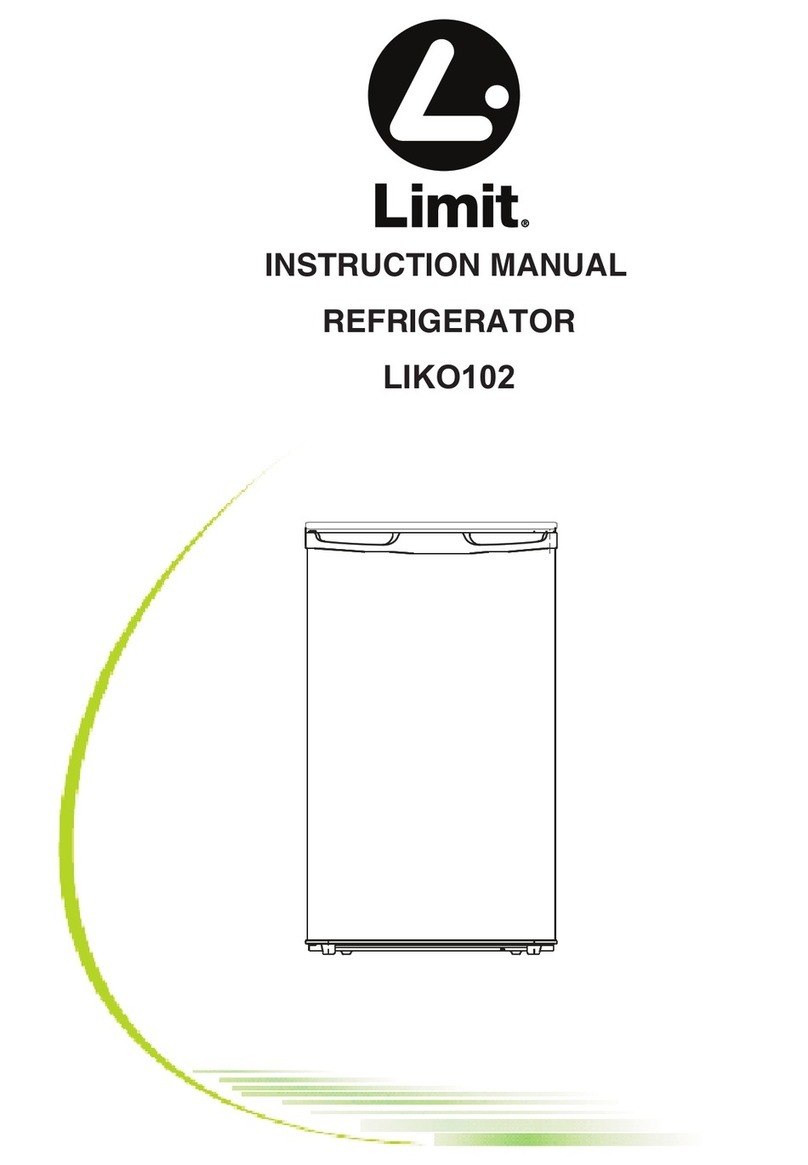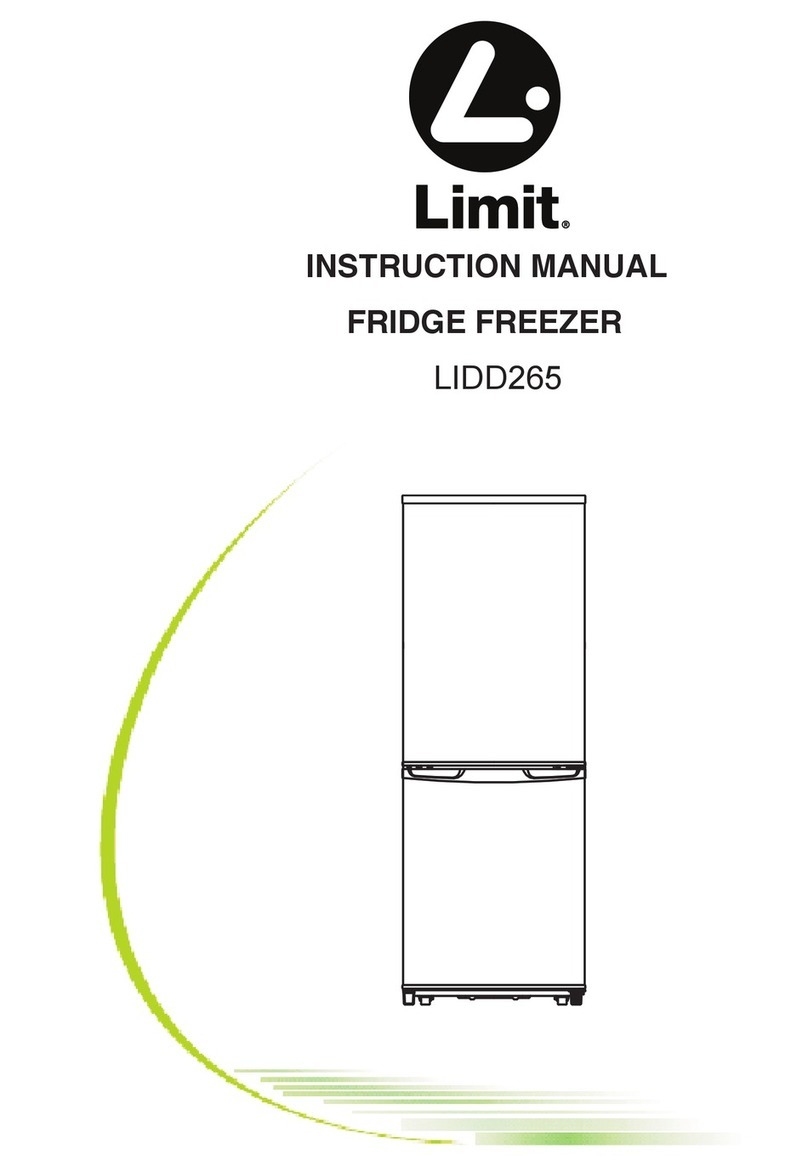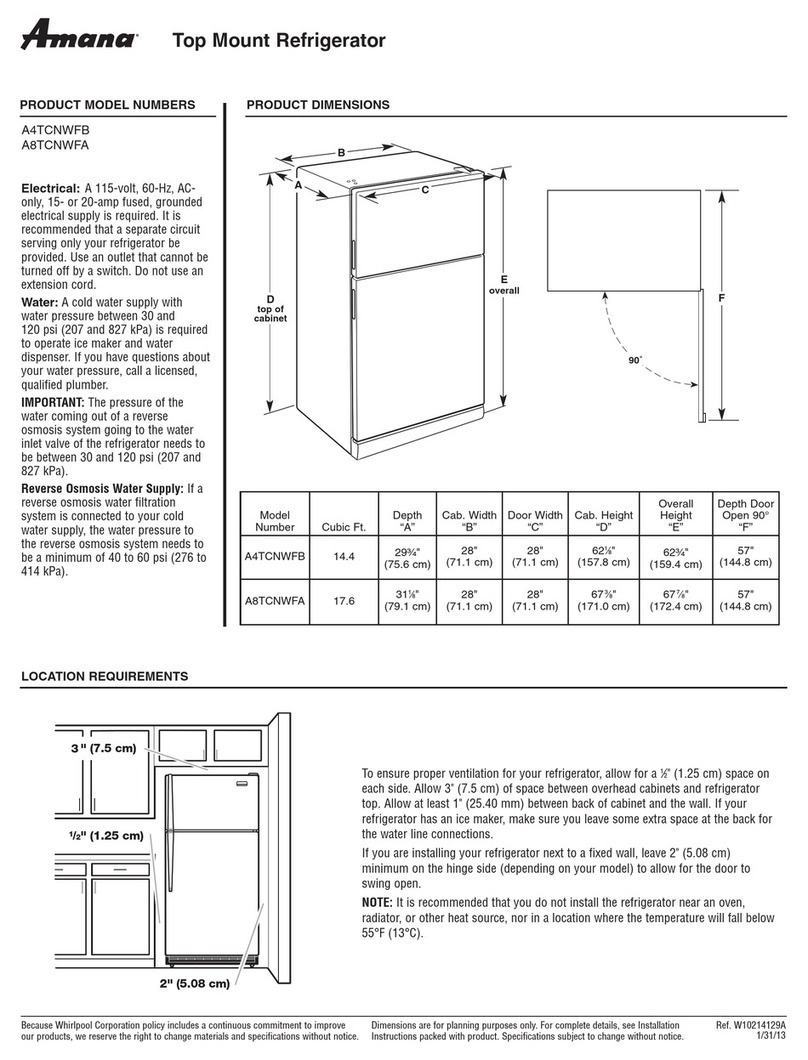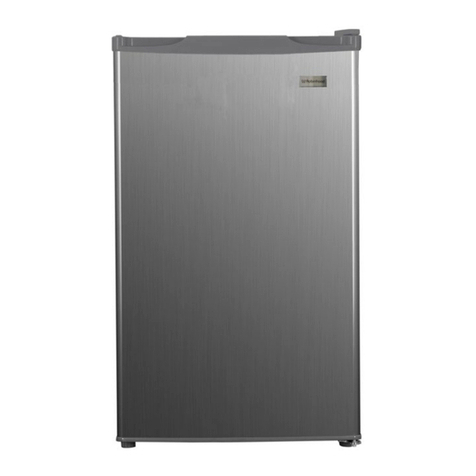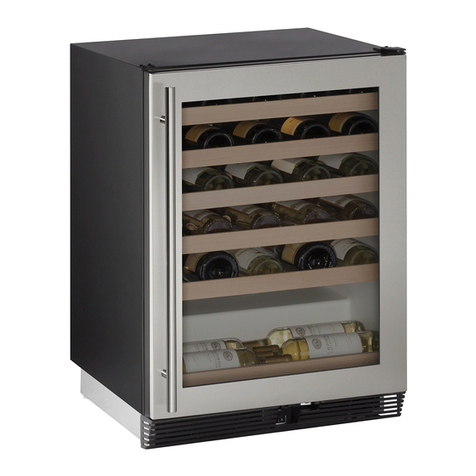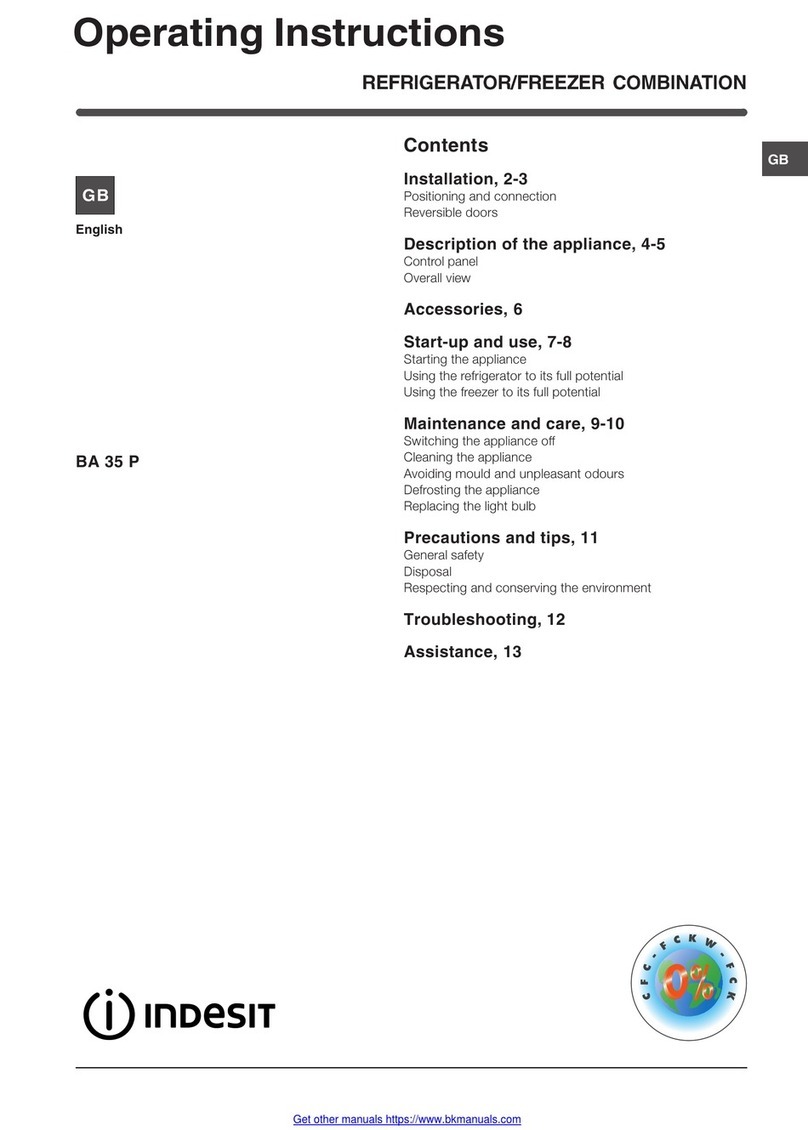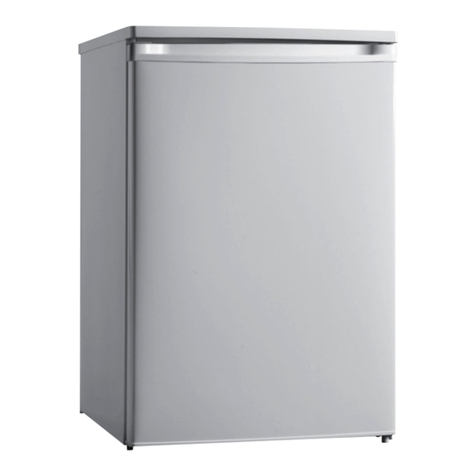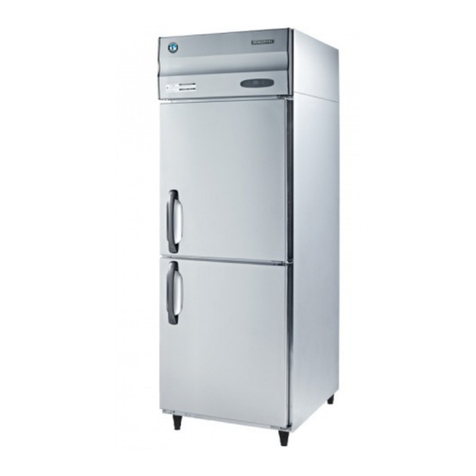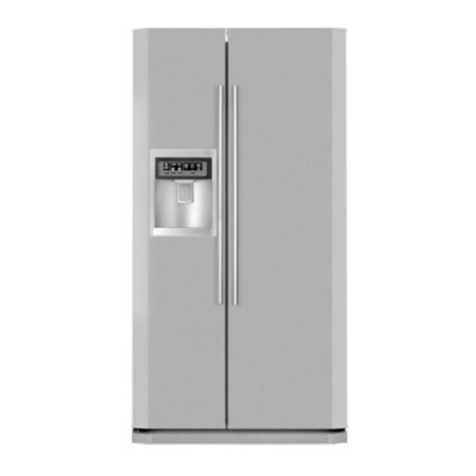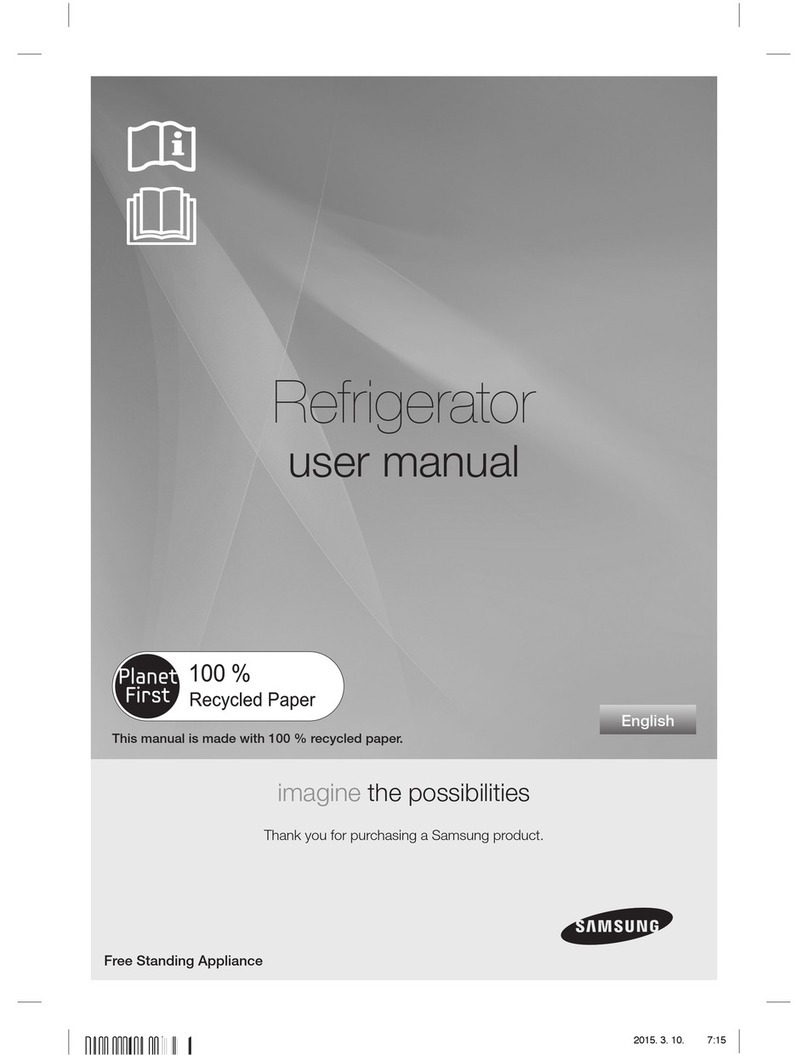LIMIT LIDD161 User manual

INSTRUCTION MANUAL
FRIDGE FREEZER
LIDD161

1
3
3
4
5
6
7
8
9
11
1

2

ventilation, follow the instructions relevant
to the installation.
Wherever possible, the back of the
product should be against a wall to avoid
touching or catching warm parts
(compressor, condenser) and to prevent
the risk of fire; follow the instructions
relevant to installation.
The appliance must not be located close
to radiators or
Make sure that the main plug is accessible
after installation of the appliance.
cooking appliances.
Any electrical work required to do the
servicing of the appliance should be
carried out by a qualified electrician or
person.
This product must be serviced by an
authorized service center, and only
genuine spare parts must be used.
authorized
Service
Control panel
Starting up and temperature regulation
The temperature selector knob is located
on the top of the refrigerator compartment.
Setting “MIN” means
Setting “MAX” (end-stop) means
Highest temperature, warmest setting.
Lowest temperature, coldest setting.
Important! Normally, we advise you select
a setting ;if you want the
temperature higher or lower, please turn the
knob to a warmer or colder setting
accordingly. When you turn the knob to a
er can lead to more energy
efficiency. Otherwise, it would result the
.
cold setting, this
consumption of energy
Insert the plug of the connection lead into
the plug socket with a protective
contact. When the refrigerator
compar-ment door is opened, the internal
lighting is switched on.
grounding
Description of the appliance
View of the appliance
2) If the appliance contains a freezer compartment.
1) If the appliance is Frost Free.
Setting “OFF” means
.
Turning in a clockwise direction the refrigerating
unit turns on automatically.
Off
it will then operate
Note: Due to continual modification of our products, your refrigerator may be slightly different
from this Instruction Manual, but its functions and usage methods remain the same.
3
“ MED ”
1. bulb & temperature regulator
2. Storage shelf.
3. Crisper
4 Lower drawer in freezer
5.
6. Lower door shelf
Adjustable feet

First use and installation
Cleaning before use
Before using the appliance for the first
time, wash the interior and all internal
accessories with lukewarm water and
neutral soap remove the typical
smell of a brand new product, then dry
thoroughly.
in order to
Installation Positioning
Warning! Before installing, read the
instructions carefully for your safety
and the correct operation of the appliance.
Position the appliance away from sources
of heat such as stoves, radiators, direct
sunlight, etc.
Maximum performance and safety are
guaranteed by maintaining the correct
indoor temperature for the class of unit
concerned, as specified on the rating
plate.
This appliance performs well from N to ST.
The appliance may not work properly if it
is left for a longer period at a temperature
above or below the indicated range.
and low power consumption.
sufficiently cleared refrigerator
refrigerator sides, a
height
For this reason,
ebdluohsecapsa
available around the . It is
advisable for there to be 75mm separating
the back of the to the wall at
least 100mm of space on its two
of over 100mm from its top and a
clear space in front to allow the doors to
open 160°.
Climate class Ambient temperature
SN
N
ST
T
+10°C to +32°C
+16°C to +32°C
+16°C to +38°C
+16°C to +43°C
Changing the light bulb
Warning! If the light bulb is
damaged, only a qualified electrician
must carry it out!
The changing of an
personnel
bulb by inexperienced
persons may cause injury or a serious
malfunction. It must be replaced by a qualified
in order to avoid a hazard. Contact
your local Service Force Center for help
Light bulb data: 220-240 V.
Thermostat
knob
Bulb (inside)
To switch off the appliance, set the
temperature regulator to position “0” or
un
Press the bulb in the center with finger.
Take out the lampshade with “1” type
screwdriver, change the bulb, and then
replace the lampshade.
Put the refrigerator back into operation.
plug the mains plug.
Lampshade
Important! High ambient temperatures (e.g.
on hot summer days) and a cold setting on
the temperature regulator (position ) can
cause the compressor to run continuously or
even non-stop!
Reason: when the ambient temperature is
high, the compressor must run continuously to
maintain the low temperature in the appliance.
Before changing the light bulb, switch off the
appliance and unplug it, or pull the fuse or
the circuit breaker.
75mm
100mm
100mm
Important! It is necessary to have good
ventilation around the refrigerator to allow
for the dissipation of heat, high efficiency,
“MAX”
4

Appliances must not be exposed to rain.
Sufficient air must be allowed to circulate
in the lower rear section of the appliance,
as poor air circulation can affect perfor-
mance. Built-in appliances should be
positioned away from heat sources such
as heaters and direct sunlight.
Leveling
The appliance should be level in order to
eliminate vibration. To make the appliance
Electrical connection
Caution! Any electrical work required to
install this appliance should be carried out by
qualified or .authorized personnel
This appliance must be grounded.
The manufacturer declines any liability should
these safety measures not be observed.
Warning!
the floor. You can also adjust the level by
the appropriate level
the front (use your fingers or a suitable
spanner).
unscrewing adjustment
in
Daily use
Accessories
Movable shelves/trays
1)
Various glass, plastic storage shelves or
wire trays are included with your appliance-
different models have different combinations
and different models have different
The walls of the refrigerator are equipped
with a series of runners so that the
shelves can be positioned as desired.
features.
Positioning the door shelves
To permit the storage of food packages of
various sizes, the door shelves can be
placed at different heights.
To gradually pull the shelf in the
direction of the arrows until it comes free,
then reposition as required.
adjust,
Vegetable Drawer
For storing fruit and vegetables.
Freezer Drawer
For storing frozen food.
Ice-cube tray
For making ice and storing ice-cubes.
Refrigerator compartment 2)
For storing food that does not need to be
frozen and different sections suitable for
different kinds of food.
Freezer food compartment 2)
For freezing fresh food and storing frozen
and deep-frozen food for long periods of
time.
Thawing food 2)
In the refrigerator compartment.
At room temperature.
In a microwave oven.
In a conventional or convection oven.
Food once thawed should be re-frozen
with the exception of special cases.
1) If the appliance contains related accessories
and functions.
2) If the appliance contains a freezer compartment.
level, it should be upright and both
adjusters should be within stable contact
5

Helpful hints and tips
Noises during operation
Clicks-
Humming-
Bubbling-
Splashing-
Whenever the compressor switches
on or off, a click can be heard.
As soon as the compressor is in
operation, you can hear it humming.
When refrigerant flows into thin
tubes, you can hear bubbling or splashing
noises. Even after the compressor has
been switched off, this noise can be heard
for a short time.
Energy saving tips
Do not install the appliance near stoves,
radiators or other sources of warmth.
Keep the time the appliance is open to a
minimum.
Do not set the temperature colder than
necessary.
Make sure the side plates and back plate
of the appliance are at some distance
from the wall, and follow the instructions
relevant to installation.
f the diagram shows the correct
combination for the drawers, crisper and
shelves, do not adjust the combination as
it would produce an effect on energy
consumption.
I
Hints for fresh food refrigeration
Do not store warm foods or evaporating
liquids in the appliance.
Do cover or wrap the food, particularly if it
Hints for refrigeration
Meat (all types): wrap in
bags and place on the glass shelf
above the vegetable drawer. For safety,
store in this way only one or two days at
the most.
Cooked foods, cold dishes, etc…: these
should be covered and may be placed on
any shelf.
Fruit and vegetables: these should be
thoroughly cleaned and placed in the
special provided.
polyethylene
(plastic)
drawer
has a strong flavor .
Position food so that air can circulate
freely around it.
or odor
Hints for freezing
Prepare food in small portions to enable it
to be rapidly and completely frozen and to
make it possible to thaw
only the quantity required.
subsequently
When first starting-up or after a period out
of use. Before putting the food in the
compartment, let the appliance run at
least 2 hours on the higher settings.
Milk bottles: these should have a cap and
should be stored in the bottle rack on the
door.
Wrap up the food in aluminum foil or
and make sure that
the packages are airtight.
Do not allow fresh, unfrozen food to touch
food that is already frozen, thus avoiding a
rise in the temperature of the latter.
polyethylene (plastic)
It is recommended to label and date each
frozen package in order to keep track of
the storage time.
H
intsforthestorageoffrozenfood
Make sure that commercially frozen food
was stored by the retailer.
Once defrosted, foods deteriorate rapidly
and can not be re-frozen.
Do not exceed the storage period
indicated by the food manufacturer.
If the appliance contains related
accessories and functions.
Note:
Butter and cheese: these should be
placed in aluminum foil or
bags as much air
as possible.
polyethylene
(plastic) while removing
Iced products, if consumed immediately
after removal from the freezer compartment,
can possibly cause skin to become freezer
burnt.
6

Cleaning and Care
Cleaning and care
For hygienic reasons, the appliance interior,
including interior accessories, should be
cleaned regularly.
The appliance should be cleaned and
maintained at least every two months.
Warning! Danger of electrical shock!
The appliance should not be connected to
the during cleaning.
Before cleaning, switch the appliance off
and remove the plug from the
switch off, or the circuit
breaker or fuse.
main power supply
main power
supply, shut off
Notice!
Remove the food from the appliance
before cleaning. Store them in a cool
place well covered.
Never clean the appliance with a steam
cleaner. Moisture could accumulate in
electrical components.
Hot vapor can lead to the damage of
plastic parts.
Ethereal oils and organic solvents can
attack plastic parts, e.g. lemon juice or the
juice from an orange peel, butyric acid,or
cleansers that contain acetic acid. Do not
allow such substances to come into
contact with appliance parts.
Do not use any abrasive cleansers.
and keep
Defrosting
Defrosting in the fresh food storage
compartment
This is automatically controlled by
switching the temperature regulator ON or
OFF so that there is no need
defrosting . Water from the
defrosting will be
drained into a drip tray through a drain
pipe at the back of the .
to use the
setting
option automatically
appliance
Clean the appliance and the interior
accessories with a cloth and lukewarm
water. Commercially available dish
washing detergents may also be used.
After cleaning, wipe with fresh water and
a clean dish cloth.
Accumulation of dust at the condenser
increases energy consumption; clean the
condenser at the back of the appliance
once a year with a soft brush or a vacuum
cleaner.(Only for the outside-condenser
product)
Check the water drain hole on the rear
wall of the refrigerator compartment.
Clear a blocked drain hole with the aid of
something like soft green peg, an be
careful not to any damage to the
cabinet by sharp
After everything is dry, the appliance back
into service.
create
objects.
Defrosting in the frozen food storage
compartment
Defrosting in the freezer chamber is
operated manually. Before defrosting, take
the food out.
Take the ice tray and drawers out or put
them into the fresh food compartment
temporarily.
Set the knob of the temperature regulator
to the “0” (where the compressor will stop
working) and leave the door of the
refrigerator open until ice and frost
dissolve thoroughly and at the
bottom of the freezer chamber. Wipe out
the water with a soft cloth.
In up the process of
defrosting, you may put a bowl of warm
water (about 50°C) into the freezer chamber
and scrape away the ice and frost with a
defrosting spatula. After doing so, be sure to
set the knob of the temperature regulator to
the original position.
It is not advisable to heat the freezer
chamber directly with hot water or a hair
dryer while defrosting to avoid deformation
of the inner case.
It is also not advisable to scrape off ice
accumulate
order to speed
and frost or separate foods from the
containers which have been congealed
together with the food with sharp tools or
wooden bars, so as not to damage the
inner casing or the surface of the
evaporator.
Warning!
Notice!
off the appliance before
defrosting, turn the temperature regulator to
the “0” position.
The should be defrosted
at least once a month. During its usage, if
the door opened frequently the
appliance has been used in extreme
humidity, we advise the user to defrost every
two weeks.
To switch
appliance
has been
Empty the appliance.
Pull out the power plug.
Clean thoroughly (see section: Cleaning
and Care).
Leave the door open to prevent odours.
Taking the appliance out of service
7

The food is too warm.
Interior lighting does
not work.
Unusual noises.
The compressor does
not start immediately
after changing the
temperature setting.
Water on the floor or
storage shelves.
Temperature is not properly
adjusted.
Door was open for an
extended period.
Alarge quantity of warm food
was placed in the appliance
within the last 24 hours.
The appliance is near a heat
source.
Light bulb is defective.
Door seal is not air-tight
(possibly after reversing the
door).
Appliance is not level.
The appliance is touching the
wall or other objects.
Acomponent, e.g. a pipe, on
the rear of the appliance is
touching another part of the
appliance or the wall.
This is normal, no error has
occurred.
Water drain hole is blocked.
Please the “Initial Start Up”
section.refer to
Open the door only as long as
necessary.
Turn the temperature regulator
to a colder setting temporarily.
Please the “Installation
Location” section.
refer to
Please look in the “Changing the
Light Bulb “section.
Carefully warm the leaking
sections of the door seal with a
hair dryer (on a cool setting). At
the same time, shape the warmed
door seal by hand so that it sits
correctly.
Readjust the feet.
Move the appliance slightly.
If necessary, carefully bend the
component out of the way.
The compressor starts after a
period of time.
Refer to the “Cleaning and Care”
section.
Heavy build-up of
frost, possibly also on
the door seal.
What to do if…
Problem Possible cause Solution
Appliance does not
work.
Appliance cools too
much.
Appliance is not switched on.
Main plug is not plugged in or
is loose.
Fuse has blown or is defective.
Outlet is defective.
Temperature is set too cold.
Switch on the appliance.
Plug the appliance into the
electrical socket.
Check fuse, replace if necessary.
Defective parts need
repaired to be
by an electrician.
Turn the temperature regulator to
a warmer setting temporarily.
Warning! Before trouble-shooting,
disconnect the power supply. Only a
qualified electrician or other
personnel must carry out the trouble-
shooting that is not in the manual.
Important!
Repairs to the appliance may only be
performed by competent service engineers.
Improper repairs can give rise to significant
hazards for the user. If your appliance
needs repairing, please contact your
specialist dealer or your local Customer
Service Center.
8

3. Remove the upper hinge core, transfer it
to left side and tighten securely, then put it in
a safe place.
4. Remove the two flange screws, then
remove the middle hinge that holds the
lower door in place. Lift the lower door and
place it on a padded surface to prevent
scratching it.
5. Remove the hinge hole cover from the
holes as illustrated and transfer them to the
uncovered hole on the side.
left
right
6. Remove both adjustable feet and the
bottom hinge bracket by unscrewing the
bolts.
Reversing the door
1. Stand the refrigerator, use a flat-bladed
screw driver to remove the 4 screw covers at
the rear of the refrigerator lid.
2. Unscrew and lift the lid from the rear and
remove it, then lift the upper door and place
it on a padded surface to prevent it
scratched. from
becoming
The side in which the door opens can be
changed from the right side (as supplied) to
the left side, if the installation site
Tools you will need:
1. 8mm socket driver
2. Cross-shaped screwdriver
allows for it.
3. Putty knife or thin-blade screwdriver
9

7. Unscrew and remove the bottom hinge
pin, turn the bracket over and replace it.
Refit the bracket holding the bottom hinge
pin. Replace both adjustable feet. Transfer
the lower door to the proper position. Secure
the level of the door, put the bottom hinge
pin into the lower hole of the door, then
tighten the bolts.
8. Allow the middle hinge to reverse the
direction 180 degrees, then transfer it to the
left position properly. Put the middle hinge
pin in the upper hole of the lower door, then
tighten the bolts. Transfer the upper door to
the proper position. Secure the level of the
door; put the middle hinge pin into the lower
hole of the upper door.
9.Replace the lid by fitting the upper hinge
core into the upper door’s hole, securing it
with the 4 screws.Replace the screw covers.
When you reverse the door,
please do the following :
1. Move the accessory from the upper
cover of the upper door and attach
accessory that is a small detachable part
from a small bag.
B
A
Warning!
When changing the side at which the door
opens, the appliance must not be connected
to the main outlet.
B
A
2. Remove the screw(1) that hold the door
stopper(3),then remove the door stopper(3).
3. Insert the door stopper(2),then tighten the
screw(1).
1
2
3
10

Disposal of the appliance
Correct disposal of this product
It is prohibited to dispose of this appliance in domestic household waste.
Packaging materials
Before disposal of the appliance.
Packaging materials with the recycle symbol are recyclable. Dispose of the packaging in a
suitable container to recycle it.
1. Disconnect the main plug from the main socket.
2. Cut off the main cable and discard it.
waste collection
This symbol on the product, or in its packaging, indicates that this
product may not be treated as household waste. Instead, it should
be taken to the appropriate waste collection point for the recycling of
electrical and electronic equipment. By ensuring this product is
disposed of correctly, you will help prevent potential negative
consequences for the environment and human health, which could
otherwise be caused by the inappropriate waste handling of this
product. For more detailed information about the recycling of this
product, please contact your local council, your household waste
disposal service, or the shop where you purchased the product.
11

MANUEL D’UTILISATION
REFRIGERATEUR
LIDD161

1
3
3
4
5
6
7
8
11
11
1
1

2

OFF
MIN
MAX
MED

Avant de changer l’ampoule de la lampe,
éteignez l’appareil et débranchez-le, ou
enlevez le fusible ou le coupe circuit.
●Propriétés de l’ampoule: 220-240V
●Pour éteindre l’appareil, régler la position
du régulateur a « 0 »
●Appuyez sur l’ampoule au centre avec le
doigt
●Retirez le cache ampoule avec un tournevis
de type « 1 », changez l’ampoule puis
replacez le cache
●Remettez le réfrigérateur en marche.
Important! Les températures ambiantes
élevées (ex: pendant les journées chaudes
d’été) associées à un réglage froid ("MAX"
, peuvent entraîner le fonctionnement en
continu du compresseur, parfois sans arrêt!
Raison: lorsque la température ambiante
est élevée, le compresseur fonctionne en
continu an de maintenir l’appareil à une
température faible.
Remplacement de l’ampoule
Attention! Si l’ampoule est
endommagée, seul un électricien
qualié peut la remplacer!
Faire remplacer l’ampoule par une personne
non qualiée peut provoquer des blessures
physiques graves ou un dysfonctionnement
important du système. Seules les personnes
qualiées sont autorisées à effectuer ce
type d’opération, an de limiter les risques.
Contactez une entreprise spécialisée pour
vous faire aider.
Nettoyage avant utilisation
●Avant d’utiliser l’appareil pour la première
fois, nettoyez l’intérieur ainsi que tous les
accessoires intérieurs, au moyen d’eau
tiède savonneuse an de supprimer l’odeur
typique des produits neufs, puis séchez
entièrement.
Installation/Emplacement
Attention! Avant d’installer l’appareil,
lisez attentivement les consignes de
sécurité et d’utilisation du système.
●Placez l’appareil à distance des sources
de chaleur telles que les fours, radiateurs,
rayons directs du soleil, etc.
●Cet appareil fonctionnera dans les
meilleures conditions si vous respectez
la température intérieure conseillée sur la
plaque nominative.
●L’appareil ne fonctionnera pas
correctement s’il est laissé pendant
une longue période à une température
supérieure ou inférieure à celle
mentionnée.
Important! Il est nécessaire d’avoir une
bonne aération autour du réfrigérateur pour
Installation et mise en route
permettre la dissipation de la chaleur, son
bon rendement, et une faible consommation
d’électricité. Pour cette raison, un espace
sufsant devra être disponible autour du
fridge. Il est conseillé d’avoir un espace
de75mm entre l’arrière du réfrigérateur et le
mur et au moins 100mm d’espace sur ses
deux côtés, une hauteur de plus de 100mm
au dessus et un espace libre devant pour
permettre une ouverture de la porte à 160°.
Type de climat Catégories de températures
SN +10°C à +32°C
N +16°C à +32°C
ST +16°C à +38°C
T +16°C à +43°C
75mm
100mm
100mm
Ampoule
(intérieure) Cache
ampoule
Thermostat
4

Utilisation quotidienne
Accessoires 1)
Etagères/Plateaux amovibles
●Plusieurs étagères ou plateaux en plastique
sont fournis avec votre appareil. Les
différents modèles présentent des propriétés
différentes.
●Les parois du réfrigérateur sont dotées
de plusieurs rails destinées à recevoir les
étagères et les plateaux.
Positionnement des étagères
●Pour faciliter le stockage des emballages
de différentes tailles, les étagères peuvent
être placées à différentes hauteurs.
●Pour régler la hauteur des étagères,
tirez légèrement l’étagère dans le sens
indiqué par la èche jusqu’à la libérer, puis
repositionnez la selon vos préférences.
Compartiment à légumes
●Pour le stockage de fruits et légumes.
Tiroir Congélateur
●Pour le stockage de nourriture congelée.
Bac à glaçons
Pour faire de la glace et stoker des glaçons.
Compartiment réfrigérateur 2)
●Pour stocker la nourriture qui n’a pas
besoin d’être congelée et il y a différentes
parties pour différents types de nourriture.
Compartiment congélateur 2)
●Pour la congélation de nourriture fraîche
et stocker de la nourriture congelée et
fortement congelée pendant longtemps.
Décongélation de la nourriture 2)
●Dans le compartiment à congélation
●A température ambiante
●Dans un four à micro ondes
●Dans un four conventionnel ou un four à
chaleur tournante.
●Une fois décongelés, les aliments ne
peuvent être congelés de nouveau que
dans des cas exceptionnels.
1) Si l’appareil est doté des accessoires et des fonctions
citées.
2) Si le système est doté d’un compartiment à congélation.
●Ne jamais exposer l’appareil à la pluie. Un
espace sufsant doit être laissé à l’arrière
de l’appareil, an de faciliter la circulation
de l’air. Un manque de ventilation peut
détériorer le fonctionnement de l’appareil.
L’appareil doit être placé à distance des
sources de chaleur ou des rayons directs
du soleil.
Mise à niveau
●Pour éliminer les vibrations, cet appareil
doit être à niveau. Pour cela, il doit être
installé bien droit et les deux pieds de mise
à niveau doivent être fermement en contact
avec le sol. Vous pouvez également le
mettre à niveau manuellement au moyen
d’une cale à l’avant ou à l’arrière (si le sol
est incliné).
Branchement électrique
Attention! Toutes les interventions
électriques nécessaires pour l’installation de
cet appareil doivent être effectuées par une
personne compétente et qualiée.
Attention! Cet appareil doit être relié au
sol. Le fabricant décline toute responsabilité
si ces mesures de sécurité ne sont pas
observées.
5

Astuces et conseils utiles
Bruits pendant le fonctionnement
« Clics »: dès que le compresseur passe sur
Marche ou Arrêt, vous entendrez un « clic »
Bourdonnements: lorsque le compresseur
est en fonctionnement, vous pouvez entendre
un bourdonnement.
«Gargouillis»: lorsque le liquide réfrigérant
circule dans les conduits, vous pouvez
entendre des gargouillis ou des bruits
similaires à des éclaboussures.
Eclaboussures: même après extinction du
compresseur, ce bruit peut continuer pendant
quelques minutes.
Conseils pour économiser l'énergie
●N’installez pas l'appareil à proximité de
cuisinières, de radiateurs ou d’autres
sources de chaleur.
●Ouvrez l’appareil un minimum de temps.
●Ne réglez pas la température sur une
valeur plus froide que nécessaire.
●Assurez-vous que les plaques latérales
et la plaque arrière de l'appareil sont à
une certaine distance du mur, suivez les
instructions pertinentes à l'installation.
●Si le schéma indique la combinaison
correcte des tiroirs, du bac et des clayettes,
ne réglez pas la combinaison car cela
pourrait entraîner une surconsommation
d’énergie.
Conseils pour la réfrigération des
aliments frais
●Ne stockez pas d’aliments chauds ou de
liquides qui s’évaporent dans l’appareil.
●Ne couvrezpaset n'emballezpaslesaliments,
surtout s’ils dégagent une odeur forte.
●Placez les aliments de façon à laisser l’air
circuler autour.
Conseils pour la réfrigération
●Viande (tous les types): enroulez les
morceaux de viande dans des sacs
polythène et disposez-les sur l’étagère en
verre située au-dessus du compartiment à
légumes. Pour votre sécurité, stockez un
ou deux jours au plus.
●Aliments cuits, plats froids, etc…: conservez-
les sur n’importe quelle étagère. Fruits et
légumes : nettoyez-les bien et rangez-les
dans le compartiment réservé à cet effet.
●Fruits et légumes : ils doivent être bien
lavés et placés dans le bac approprié fourni.
●Beurre et fromages: enroulez-les dans du
papier aluminium ou dans des sacs en
polyéthylène an d’exclure le maximum
d’air possible.
●Bouteilles de lait: elles doivent être dotées
d’un capuchon et rangées dans le
compartiment à bouteilles situé dans la
porte du réfrigérateur.
Astuces pour la congélation
●Lors du premier démarrage ou après une
période de non utilisation. Avant de mettre
de la nourriture dans le compartiment,
laissez fonctionner l’appareil au moins 2
heures avec les réglages élevés.
● Préparez de petites portions an de
faciliter la congélation et ainsi ne congeler
que la quantité nécessaire.
●Enroulez les aliments dans du papier
aluminium ou dans des sacs en
polyéthylène et assurez-vous que les
emballages ne laissent pas passer l’air.
●Ne laissez pas les aliments frais ou
décongelés entrer en contact avec des
produits congelés, car cela risquerait
d’entraîner une augmentation de la
température sur ces derniers.
●Produits glacés, s’ils sont consommés
immédiatement après retrait du
compartiment de congélation, cela peut
causer des gerçures sur la peau.
●Il est recommandé d’étiqueter et de dater
chaque emballage congelé dans le but de
garder une trace de la date de stockage.
Astuce de rangement pour aliments
déjà congelés
●Assurez-vous que les aliments congelés
vendus dans le commerce étaient
correctement congelés par le vendeur.
●Une fois décongelés, les aliments se
dégradent vident et ne peuvent plus être
recongelés.
●Ne dépassez pas la durée de congélation
indiquée sur l’emballage.
Remarque: si l’appareil est doté des
accessoires et des fonctions citées.
6

Nettoyage et entretien
Nettoyage et entretien
Pour des raisons d’hygiène, les composants
intérieurs de l’appareil, y compris les accessoires,
doivent être nettoyés régulièrement.
L’appareil devra être nettoyé et entretenu au
moins tous les deux mois.
Attention! Risque d’électrocution!
rangement des aliments frais
●Il est controlé automatiquement en plaçant
le thermostat sur ON ou OFF. Il n’est donc
pas nécessaire d’utiliser le dégivrage,
L’eau de l’option dégivrage s’écoulera
automatiquement sur un plateau par tuyau
d’écoulement au dos de l’appareil.
Dégivrer le compartiment à
réfrigération
●Pour dégivrer le compartiment à congélation,
vous devez procéder manuellement. Avant le
dégivrage, retirez tous les aliments.
●Retirez les plateaux et les tiroirs pour les placer
dans le réfrigérateur le temps du dégivrage.
●Placezlerégulateur de températuresurlaposition
“0”(le compresseur arrête de fonctionner) et
laissez la porte ouverte jusqu’à ce que la glace
et le givre fondent et s’accumulent dans le
congélateur. Epongez l’eau avec un chiffon
absorbant.
●Pour accélérer le processus de décongélation,
vous pouvez placer un bol d’eau chaude
(environ 50°C) dans le compartiment à
congélation et grattez la glace avec une
raclette.Après cela, placez le régulateur de
température sur sa position d’origine.
●Nous vous déconseillons de chauffer le
compartiment à congélation directement
avec de l’eau chaude ou un sèche-cheveux
pendant le dégivrage an d’éviter la
déformation de la paroi intérieure.
●Nous ne vous recommandons pas non plus
de gratter la glace avec des objets pointus
ou des pics en bois, car cela risquerait
d’endommager la surface de l’évaporateur.
Attention ! Pour mettre l’appareil hors tension
avant le dégivrage, tournez le thermostat sur la
position « 0 »
Important! Le l’appareil doit être dégivré au
moins tous les mois. Si la porte est fréquemment
ouverte ou si l’appareil est exposé à une forte
humidité, nous vous conseillons de le dégivrer
toutes les deux semaines.
Mettre l’appareil à l’arrêt
●Videz l’appareil
●Retirez la prise électrique
●Nettoyez (voir la partie nettoyage et entretien).
●Laissez la porte ouverte pour éviter les odeurs.
●Pendant les phases de nettoyage, l’appareil
doit être débranché.Avant de nettoyer l’appareil,
coupez l’alimentation électrique, ou arrêtez le
disjoncteur.
Attention!
●Avant de procéder au nettoyage, retirez les
aliments du réfrigérateur. Rangez les aliments
dans un endroit frais, à l’abri.
●Ne nettoyez jamais l’appareil au moyen d’un
vaporetto. De la moisissure peut s’accumuler
dans les composants électriques.
●Les vapeurs chaudes peuvent conduire à une
détérioration des éléments en plastique.
●Les huiles qui s’évaporent et les solvants
peuvent attaquer les éléments en plastique,
par exemple le jus de citron ou le jus des
écorces d’orange, l’acide butyrique, ou tout
autre agent nettoyant contenant de l’acide
acétique. Ne laissez aucune de ces substances
entrer en contact avec les éléments de l’appareil.
●N’utilisez pas d’agents abrasifs.
●Nettoyez l’appareil et ses accessoires intérieurs
avec un chiffon doux et de l’eau tiède. Vous
pouvez aussi recourir aux produits spéciques
vendus dans le commerce.
●Après avoir nettoyé l’appareil, rincez-le au
moyen d’un tissu imbibé d’eau chaude.
●L’accumulation de poussière au niveau du
condensateur augmente la consommation
d’énergie. Nettoyez le condensateur à l’arrière
de l’appareil une fois par an, au moyen d’une
brosse à poils souples ou d’un aspirateur.
● Vériez le conduit d’évacuation à l’arrière du
compartiment de réfrigération.
●Si le conduit est bouché, débouchez-le au
moyen par exemple d’un agent spécique.
Faites attention à ne pas endommager le
boîtier avec des objets pointus.
●Une fois le conduit débouché, vous pouvez
remettre l’appareil en fonctionnement.
Dégivrage
Dégivrage des compartiments de
7
Table of contents
Languages:
Other LIMIT Refrigerator manuals
Popular Refrigerator manuals by other brands
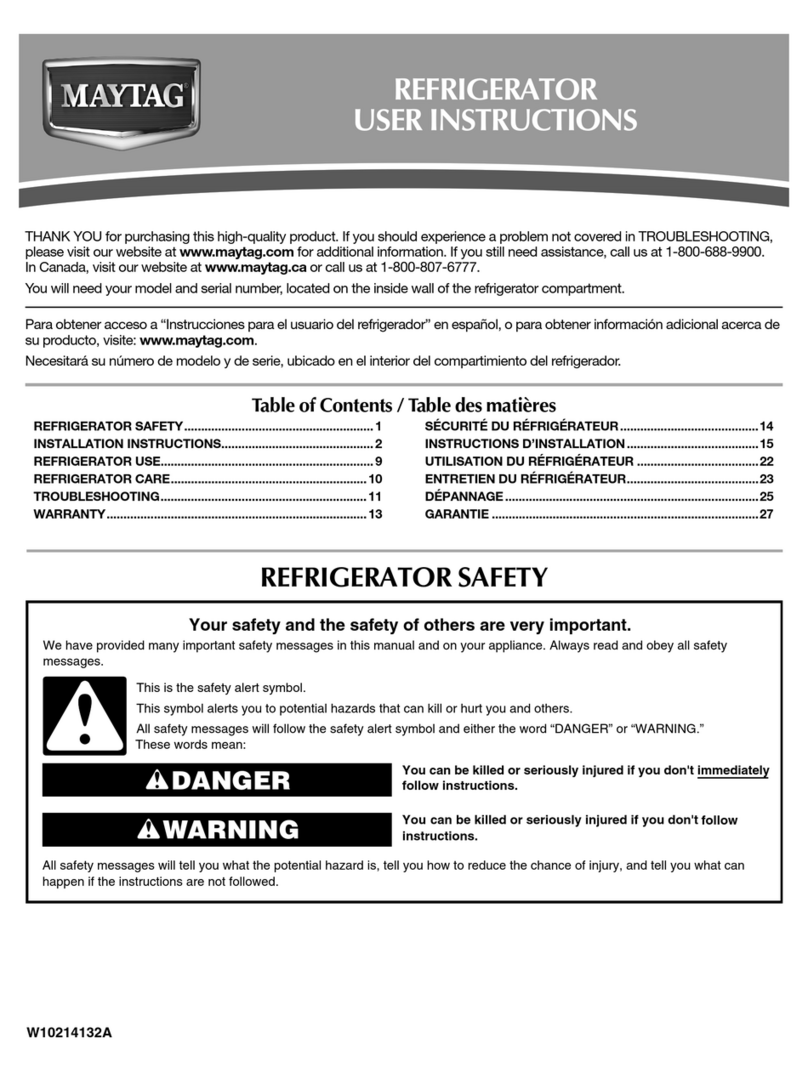
Maytag
Maytag M8RXEGMXS series User instructions
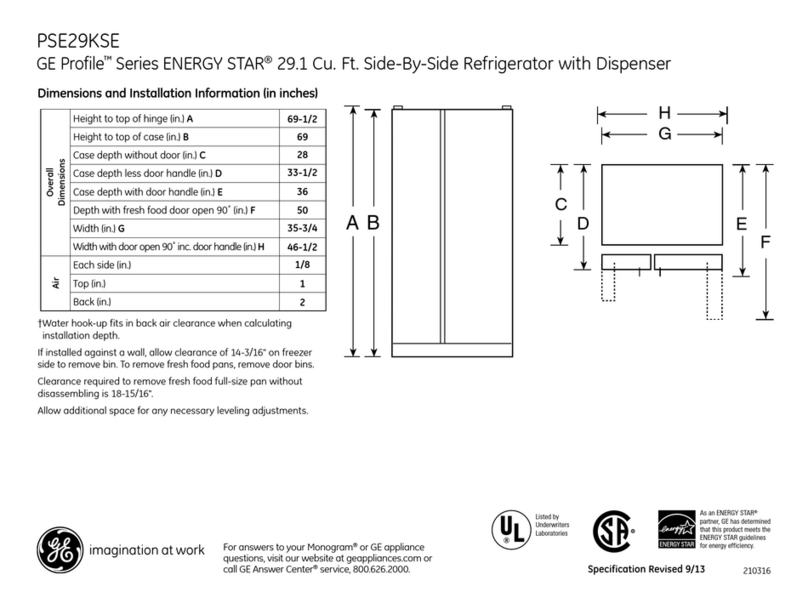
GE
GE PSE29KSESS Dimensions and installation information
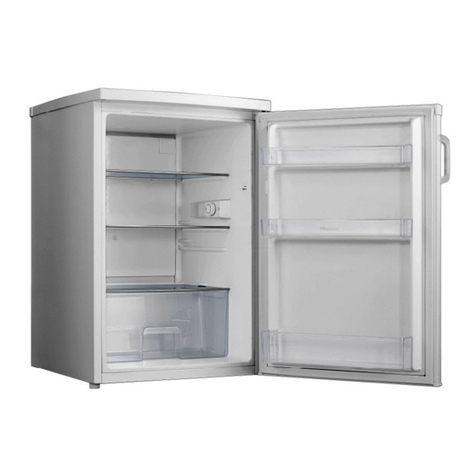
BOMANN
BOMANN VS 2195 instruction manual

Beko
Beko BL20 Installation, operation & food storage instructions

NARBONNE ACCESSOIRES
NARBONNE ACCESSOIRES 514221 operating instructions

Samsung
Samsung RFG237AAPN - 23 cu. ft. Refrigerator user manual
